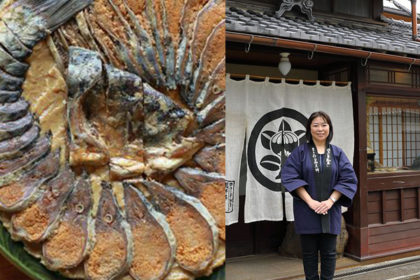
In Japan, one family has been making funazushi — the ancient, fermented predecessor to modern sushi — for 18 generations. Instead of using raw fish, funazushi uses fish aged for three years.
The funazushi-making process at Kitashina — which opened in 1619 in the small Japanese town Takashima — is labor intensive. A chef removes the fish’s scales and, without cutting into its flesh, removes the gills and innards through its throat. The fish is then packed with salt, layered in a wooden tub, weighted with over 65 pounds of stones and left to cure for two years. Then the fish is rinsed, dried in the sun for a day and fermented for another year before being ready to eat.
The microorganisms in the wooden tubs (called kioke) “naturally produce the fermentation that gives Kitashina’s funazushi its authentic flavour.” Mariko Kitamura (pictured), family owner of Kitashina , says those beneficial microorganisms would die if the tubs were ever emptied.
Though modern sushi includes ocean seafood, funazushi uses fresh water fish, particularly funa (carp). The fermented sushi technique is an adaptation of what has been used in China for thousands of years. The Chinese make narezushi using the freshwater fish that live in rice paddies.
Read more (BBC)
